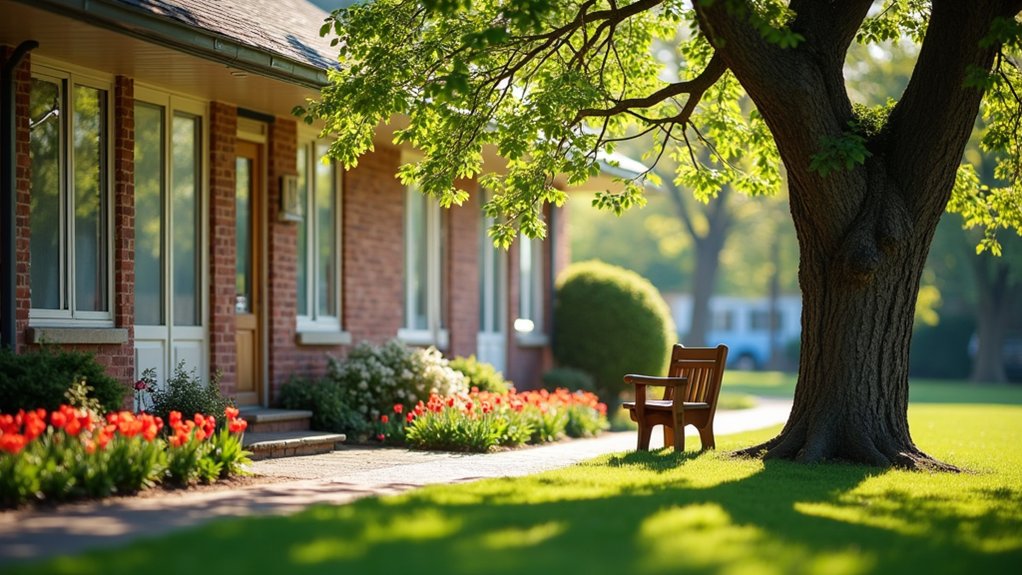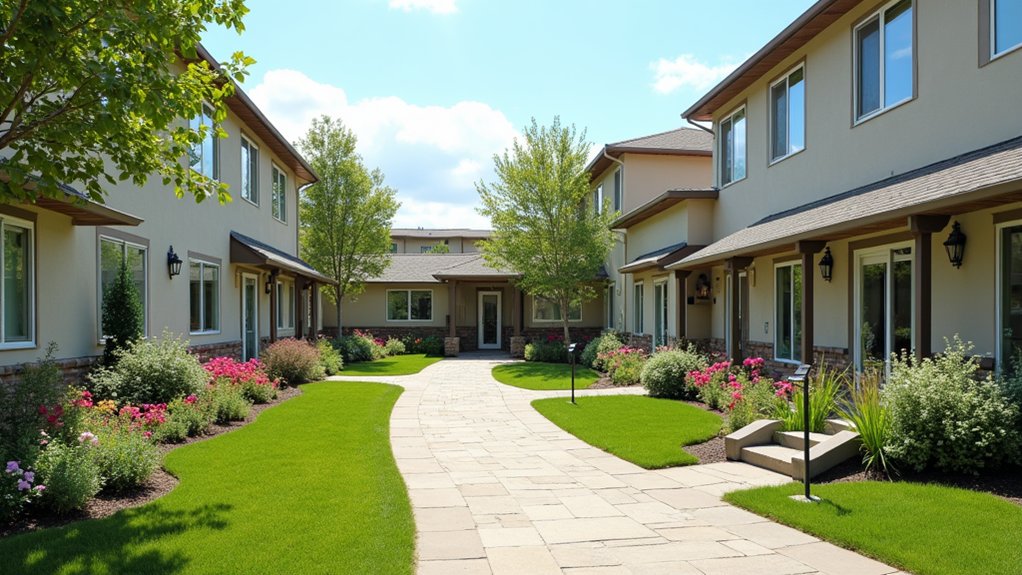Affordable Funding Solutions for Residential Care Homes

You can find affordable funding for your residential care home by tapping into government grants on Grants.gov or local subsidies. Connect with nonprofits and community groups for donations, or launch a crowdfunding campaign to engage supporters. Look into low-interest loans from local banks and explore tax credits for healthcare providers. Don’t forget private sponsorships or family contributions to share costs. Stick around to uncover even more ways to secure essential support!
Key Takeaways
- Explore federal and state grants on Grants.gov to fund care improvements for elderly and vulnerable populations.
- Connect with local nonprofits and charities for donations and community-based support.
- Utilize crowdfunding platforms like GoFundMe to raise funds transparently for specific needs.
- Research low-interest loans from healthcare-focused lenders to finance facility enhancements.
- Leverage tax credits and deductions for healthcare providers to reinvest savings into care services.
Exploring Government Grants for Care Facilities

As you seek funding for your residential care home, exploring government grants can be a game-changer. You’re driven by a passion to serve, and these grants can help turn your vision into reality.
Start by researching federal, state, and local programs designed to support care facilities. Websites like Grants.gov offer a wealth of information on available funding for health and human services. You’ll find opportunities tailored to improving care for the elderly, disabled, or vulnerable populations—exactly the people you aim to help.
Dive into the eligibility criteria and application processes with diligence. Don’t hesitate to reach out to grant officers for clarification on requirements.
Prepare a strong proposal that highlights your mission to nurture and support. Show how the funds will directly impact lives. By securing a grant, you’re not just gaining resources; you’re building a foundation to uplift those who need it most. Additionally, understanding the breakdown of expenses associated with care facilities can strengthen your proposal by demonstrating financial responsibility and planning.
Leveraging Community Support Programs
Beyond government grants, tapping into community support programs can boost your funding efforts for your residential care home. You’ve got a heart for serving others, and local organizations often share that passion.
Reach out to nonprofits, charities, and faith-based groups in your area. They might offer small grants, donations, or even volunteer support to help with operational costs. Don’t overlook crowdfunding platforms either—share your mission online to inspire community members to contribute directly.
Connect with local nonprofits and charities for grants or volunteer help. Use crowdfunding to share your mission and gain direct community support.
Also, partner with local businesses for sponsorships or in-kind donations like supplies or services. Host community events to raise awareness and funds; think bake sales or charity walks.
Engage with neighborhood associations to build a network of supporters who’ll rally behind your cause. By actively connecting with your community, you’re not just securing funds—you’re creating a circle of care that uplifts everyone involved in your mission to serve. Professional caregivers ensure quality care, allowing families to balance caregiving responsibilities with work duties.
Accessing Low-Interest Loans for Care Homes

While community support can provide a strong foundation, securing low-interest loans offers another practical way to fund your residential care home. You’ve got a heart for serving others, and these loans can help you expand your mission without breaking the bank.
Start by researching lenders who specialize in healthcare or small business financing, as they often offer competitive rates for care facilities. Don’t overlook local banks or credit unions; they might provide personalized options tailored to your needs.
Next, prepare a solid business plan to show lenders how you’ll use the funds to enhance resident care and guarantee sustainability. Highlight your commitment to the community and the impact your home makes.
Additionally, understanding Medicaid coverage duration can help you create a financial strategy that aligns with residents’ needs. Finally, compare loan terms and interest rates diligently to secure the best deal. With the right loan, you’re not just borrowing money—you’re building a brighter future for those you serve.
Utilizing Tax Incentives and Credits
How can you reduce costs for your residential care home while maximizing resources? One powerful way is by tapping into tax incentives and credits designed to support businesses like yours that serve the community.
As a care home operator, you’re dedicated to improving lives, and the government often rewards this commitment with financial breaks. Start by researching federal and state tax credits for healthcare providers or small businesses offering essential services.
For instance, you might qualify for credits related to energy-efficient upgrades or hiring specific demographics, like veterans. Don’t overlook deductions for medical equipment or facility improvements that enhance resident care. Additionally, understanding staff qualifications and training can help you identify potential tax incentives linked to workforce development.
Consult a tax professional to verify you’re claiming every benefit available. By leveraging these incentives, you’ll save money and reinvest those funds into better services, guaranteeing your residents receive the compassionate care they deserve.
Take action today to explore these opportunities!
Partnering With Nonprofit Organizations

As you seek innovative ways to fund your residential care home, consider partnering with nonprofit organizations that share your mission of supporting vulnerable populations.
These groups often have access to grants, community resources, and networks that can help ease financial burdens. By aligning with them, you’re not just gaining support; you’re amplifying your impact on those who need it most.
Start by identifying nonprofits focused on elder care, disability services, or community welfare.
Reach out to discuss potential collaborations, such as joint programs or shared fundraising events. You’ll find that many are enthusiastic to work with facilities like yours to create sustainable solutions.
Together, you can pool resources, share expertise, and advocate for the needs of your residents. This partnership isn’t just about funding—it’s about building a stronger community. Nurturing bonds through these collaborations can enhance the quality of life for those you serve.
Take the first step today and connect with a nonprofit to make a lasting difference.
Securing Private Sponsorships and Donations
Beyond partnering with nonprofits, you can also tap into private sponsorships and donations to fund your residential care home. Start by identifying local businesses, philanthropists, and community members who share your passion for supporting vulnerable individuals.
Reach out with a clear, heartfelt pitch about your mission to provide compassionate care. Show them how their contributions will directly improve lives, whether through better facilities or enhanced services.
Next, host events like open houses or fundraisers to build connections and showcase your dedication. Don’t hesitate to share personal stories of those you serve, as these can inspire generosity. Additionally, consider leveraging community engagement strategies to strengthen relationships with potential sponsors.
Create a simple donation platform on your website, making it easy for supporters to give. Finally, always express gratitude—send thank-you notes or recognize sponsors publicly.
Building these relationships isn’t just about funding; it’s about creating a community united in the mission of caring for others.
Implementing Cost-Sharing Models With Families
While securing external funding is essential, you can also explore cost-sharing models with families to sustain your residential care home. By partnering with families, you’re not just easing financial burdens but also fostering a sense of community and shared responsibility.
Start by openly discussing the costs of care and how their contributions can directly enhance their loved one’s quality of life. Tailor payment plans to fit their budgets, ensuring fairness and transparency.
Begin with honest conversations about care costs and how family contributions can improve their loved one’s life, tailoring plans for fairness and clarity.
You’ll want to clearly outline what their contributions cover, like specialized activities or personalized care services, so they see the value.
Host family meetings to build trust and gather input on how funds can best serve residents. Remember, your goal is to support those in your care, and involving families in this way strengthens your mission. Additionally, consider incorporating personalized care services to directly address the unique needs of residents, further demonstrating the value of family contributions.
With empathy and clear communication, you can create a sustainable model that benefits everyone involved.
Applying for State and Local Subsidies
Let’s explore another avenue for funding by applying for state and local subsidies to support your residential care home. These programs often aim to assist facilities like yours that provide essential care to vulnerable populations.
Start by researching available grants or subsidies through your state’s health and human services department. You’ll find specific programs tailored for elder care or disability support that can ease financial burdens.
Next, contact local government offices to uncover community-based funding options. Don’t hesitate to ask for guidance on eligibility and application processes.
Prepare detailed documentation about your home’s mission, services, and financial needs to strengthen your case. Building relationships with local officials can also help you stay informed about new opportunities. Additionally, consider how assisted living facilities can showcase your commitment to providing quality care, which may enhance your chances of receiving funding.
Exploring Crowdfunding Platforms for Support
How can you tap into the power of community support for your residential care home? Crowdfunding platforms offer a heartfelt way to connect with people who share your passion for serving others.
By creating a campaign on sites like GoFundMe or Kickstarter, you’re inviting supporters to join your mission. Share your story—why you care for residents and how their lives improve with your help. Be transparent about funding needs, whether for equipment, renovations, or daily care costs.
You’ll need to engage your audience with regular updates and gratitude. Post photos or videos showing the impact of donations, and thank contributors personally when possible.
Spread the word through social media and local networks to reach more compassionate hearts. Assisted living isn’t just about money; it’s about building a community that values your dedication.
Start today, and watch how collective kindness fuels your purpose of nurturing others.
Frequently Asked Questions
How Can Care Homes Reduce Operational Costs?
Hey, you’re always looking for ways to cut operational costs at your care home while still providing excellent service to those in need.
Start by reviewing energy usage—switch to LED lights and energy-efficient appliances.
Negotiate bulk discounts with suppliers for essentials like food and medical supplies.
Train your staff to minimize waste, too.
You’ll save money and keep focusing on what matters most: caring for your residents.
What Are Effective Staff Training Funding Options?
When you’re looking into effective staff training funding options, start by exploring government grants and subsidies designed for workforce development.
Don’t overlook local community organizations that often provide support for training programs.
Partner with educational institutions for discounted courses, and consider crowdfunding for specific training needs.
You’re dedicated to serving others, so leverage online platforms for free resources.
Keep pushing; your team’s growth directly uplifts the lives you touch every day.
How to Improve Resident Care With Limited Budgets?
Wondering how to improve resident care with limited budgets? You’ve got this!
Focus on small, impactful changes—prioritize meaningful interactions by scheduling regular one-on-one time with residents. Use free community resources like local volunteers or student programs for extra support.
Encourage staff to share creative, low-cost activity ideas. Remember, it’s your dedication that makes the biggest difference.
Keep innovating, and you’ll enhance lives without breaking the bank!
Are There Insurance Plans for Care Homes?
Hey, are there insurance plans for care homes? You bet there are!
Immerse yourself in researching specialized insurance options that cover liability, property, and even resident care issues. You’re dedicated to serving others, so don’t skip this step—protect your mission!
Check with providers who understand the unique needs of care facilities. You’ve got this; secure the right plan and keep focusing on making a difference for your residents every day.
What Technology Grants Are Available for Care Homes?
Hey, are you looking into technology grants for care homes?
You’re doing great by seeking ways to enhance care through innovation!
Check out federal programs like the Health Resources and Services Administration grants.
Don’t miss state-specific tech funds or private foundations supporting elder care tech.
Search online databases like Grants.gov, and connect with local aging councils.
You’ve got this—keep pushing to improve lives with cutting-edge solutions for those you serve!






